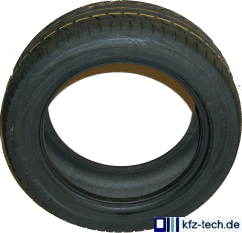|
|
 Where to mount new tyres? Where to mount new tyres?


Assignment
The above picture shows one of a possible four new tyres, and if all four tyres were always changed together, then this page would, more than likely never have been made. However, because the tyres often wear out
differently, one could, perhaps, only replace two tyres. The next question is, perhaps even when changing the complete set from summer- to winter tyres, where actually, should the best tyres be mounted?
We will
commit ourselves, this does not however, mean that there are not two schools of opinion in this matter.
Function
The better tyres are classified as those with the greatest tread-depth. It's all about driving on wet roads, because on dry roads tyres without tread are better anyhow.
To get warmed up, we would, first of all, like to give a
reason for the opinion, that the better tyres belong on the rear wheels. In this case, one assumes that there are beginners behind the steering wheel. One has to ask oneself, what would happen if a vehicle with worn out
tyres on the front wheels, breaks away in a bend on a wet road. The vehicle will understeer. The natural reaction is that the beginner steers even more into the curve, which is exactly right. If the worn out tyres were on the
rear wheels, one would have to countersteer, which even drivers with a lot of experience can't always manage. This is also the reason why most vehicles nowadays, are designed to understeer.
We are of the opinion
that the best tyres belong on the front wheels, no matter whether front- or rear-wheel drive. If the beginner observes the very simple rule of distinctly reducing the speed before entering a curve on wet roads, he/she can
avoid the situation described above. The newest generation of tyres from the various companies, show a considerable difference in their properties on wet- and not on dry roads. Therefore, in general, curves when the
roads are wet, should be carefully approached. However, what one cannot as easily foresee, are, e.g., suddenly appearing patches of water on the motorway. In the event of aquaplaning, the front axle is far more
threatened that the rear axle. Those who have experienced the situation, when neither braking nor steering has any effect at all on the vehicle, which carries on, undetered, on it's own (perhaps disastrous) course, will try,
when possible, to always have the tyres with the greatest amount of tread on the front wheels. 10/06
|
|